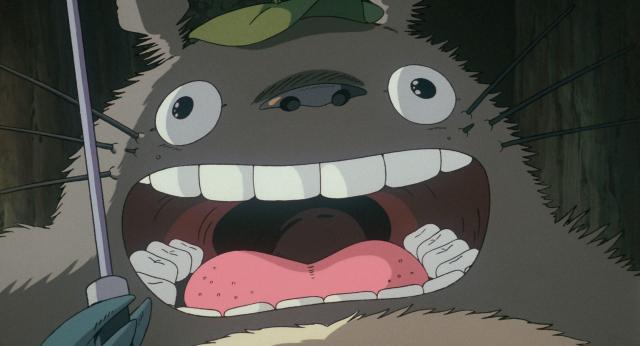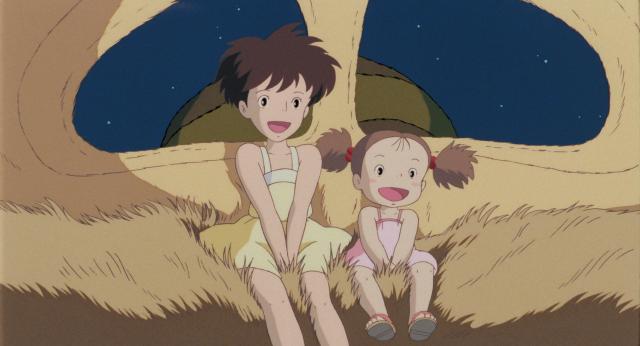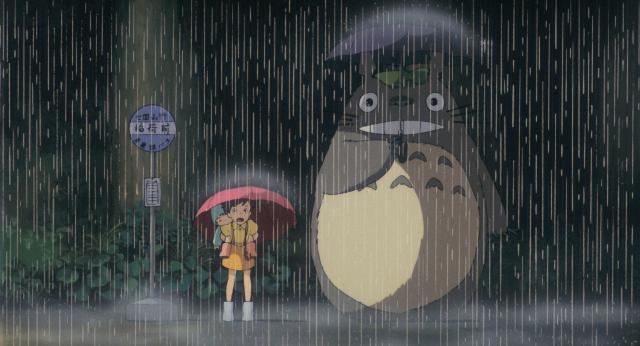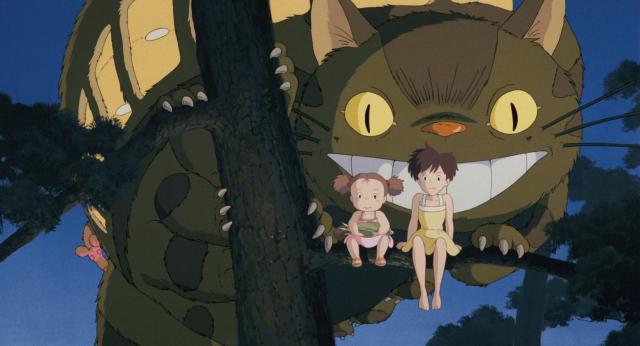
Director Hayao Miyazaki shares a number of revelations, including the real reason why there’s only one girl in the Totoro poster.
In recent years, Japanese broadcaster Nippon TV has been airing Studio Ghibli anime in its weekly Kinyo Roadshow Friday night movie slot during the summer holidays, and on 19 August, it was time for the 1988 animated feature My Neighour Totoro to be shown.
It’s become a tradition for Kinyo Roadshow to turn their annual Ghibli screenings into a mixed-media event, where behind-the-scenes trivia and secret information about the movie are published on their official Twitter account throughout the broadcast. So on Friday night, fans had one eye on the movie and one eye on Twitter, where a number of revelations about My Neighbour Totoro were shared, making everyone view the movie in a whole new light.
The biggest revelation that still has fans reeling today is the claim that Satsuki, the older sister in My Neighbour Totoro, was born in the same year as Setsuko, the young sister in Grave of the Firelies.
▼ Satsuki, left, with her younger sister Mei.
My Neighbour Totoro and Grave of the Fireflies are thematically two very different films, but they are forever connected as they debuted as a double feature in Japanese cinemas in 1988. Both films were the first to be created by Hayao Miyazaki and Isao Takahata independently from each other — they worked together as director and producer respectively on Ghibli’s first feature film Castle in the Sky — since they founded Studio Ghibli with their friend and producer Toshio Suzuki in 1985.
As both films would be screened together, Miyazaki and Takahata found themselves working within the same deadlines and time constraints, and the two directors worked together to make choices to ensure the films worked well with each other as a double feature.
Some of the choices that complement and contrast the other film include the fact that My Neighbour Totoro didn’t include any fireflies in its riverside scenes, despite it being set in the summer months, so as to make the appearance of the insects more powerful in Grave of the Fireflies. Also, the reason why Satsuki chomps into a cucumber in one scene is because Seita bites into a tomato in Takahata’s film.
「#となりのトトロ」には綺麗な水辺がたくさんありますが、蛍は登場しません。これは同時上映の「#火垂るの墓」を意識したもので、サツキがキュウリをかじるのも清太がトマトを食うシーンがあったためです。 pic.twitter.com/80r6wUmKOJ
— キャッスル@ジブリフリーク (@castle_gtm) August 19, 2022
However, the deeper, more tear-jerking connection between the two films comes with the birth-year of two of the star characters. Grave of the Fireflies is set in 1945, at the end of World War II, when Setsuko, the young girl at the centre of the movie, is four years old, making her birth year 1941.
There’s been a lot of speculation surrounding the year in which My Neighbour Totoro is meant to be set, with the era written out as “early 1950s” by Miyazaki in the original concept art for the film. However, within the film there are calendars and postmarks that show conflicting years — the calendar for May that hangs in the father’s study has “1955” written on it, while a telegram in another scene is postmarked as “August 11, 1957“, and the calendar inside the mother’s hospital room corresponds to the year 1958. However, in the first scene when the children visit their mother, the calendar dates correspond to the year 1953.
ちなみにテレビの本放送は昭和28年。お母さんの病室のカレンダーは昭和28年の6月日付配置。けれど7月のときは昭和33年の日付配置。電報の消印は32年。家のカレンダーは1955年で昭和30年なのに5月1日が火曜なのは昭和31年の日付配置。物語は昭和30年代始めと説明があったりと不思議な世界ですね pic.twitter.com/hmk4diTW12
— りね@ (@munyuyome) August 20, 2022
Whether this was an intentional choice or a pure accident remains unknown, but it’s something that’s confused fans for a long time. However, like a lot of Ghibli mysteries, delving into past interviews with Miyazaki reveals the secret behind the timeline, and this time an excerpt from the movie pamphlet for From Up on Poppy Hill reveals that Miyazaki himself once said:
“‘My Neighbour Totoro’ is set in 1953, in an era without television”.
So if My Neighbour Totoro is really set in 1953, as Miyazaki says it is, that means that Satsuki, the 12-year-old sister in the film, would’ve been born in…1941.
Why is this significant? Well, scroll down now if you don’t haven’t seen Grave of the Fireflies yet and want to avoid any spoilers. In fact, if you haven’t seen Grave of the Fireflies, now’s the perfect time to put this story on hold and go give it a watch and then come back to us. Be warned, though — you’ll probably need a big box of tissues to get through that movie and it’ll leave you so emotionally drained no amount of My Neighbour Totoro rewatches will help you recover from it.
Okay, so once you’ve sobbed your way through Grave of the Fireflies, you’ll know that…Setsuko dies in the film. It’s one of those movie moments that will be forever ingrained in the memory of anyone who’s seen it, however the revelation that Satsuki in My Neighbour Totoro was born in the same year as Setsuko sheds new light on both movies.
On one hand, it makes Grave of the Fireflies even more depressing, as it gives us an image of the young girl Setsuko could’ve grown to become, if only she’d made it through the war. However, on the other hand, it makes us realise how lucky Satsuki and her four-year-old sister Mei are to be living a peaceful life in the countryside, free from fear.
As this Twitter poster who brought the revelation to everyone’s attention puts it:
“The fact that Satsuki and Setsuko were born in the same year (1941) gives me chills down my spine. Even though the story happened in the same country and at the same time, their expressions are so different. At the time of release, ‘Totoro’ and ‘Grave of the Fireflies’ were screened as a double feature. If something were different, their lives could have been the exact opposite.”
サツキと節子が同じ年(昭和16年)生まれという設定を考えると背筋が凍りそうになる。同じ国で同じ時期に起きた物語なのに、彼らの表情はあまりにも対照的。
— 𝙂𝙀𝙈𝘼𝙍𝘼 (ジェム) (@Gemararara) August 19, 2022
公開当時『トトロ』と『火垂るの墓』は2本立て上映だった。もし何かが違ければ、彼らの人生は真逆だったかもしれない pic.twitter.com/ZSQMkEi6mA
Back when it was released as a double-feature, some cinemas screened Totoro first and Grave of the Fireflies second, while others did it the other way around. Ultimately, cinema-goers would be able to choose which one they saw first or second, depending on the time of day they went to the cinema, but we can’t help but feel for those who left the cinema in tears after Grave of the Fireflies rather than a lighter heart after Totoro.
Oh and one final connection with the year 1941 — it’s the year Miyazaki was born.
Okay, now that we’ve waded through the tear-jerking connection between the two movies, there’s another connection that’s a lot brighter, and it’s the explanation behind the girl in the My Neighbour Totoro poster. As fans of the movie will know, the promo movie for the film shows one girl who’s neither Satsuki nor Mei, but somehow we understand her as being one or both of them.
According to Kinyo Roadshow, who gets its information straight from Studio Ghibli, the reason for this is due to the fact that Miyazaki had originally intended for there to only be one girl in the movie, a seven-year-old girl called Mei.
This isn’t exactly new news, as the decision to change the story to include two girls is pretty well-known in fan circles. However, the reason behind the decision has always remained a bit of a mystery, as “storyline reasons” has remained the go-to explanation.
Kinyo Roadshow has now shed light on this as well, saying:
“Initially, Miyazaki had envisioned a scene where ‘While waiting for a bus at the bus stop a ghost appears”. Originally, the main character was set to be only one girl. After that, he learned that the screening time of ‘Grave of the Fireflies’, which was set to screen alongside ‘My Neighbour Totoro’, was longer than planned, so Miyazaki changed things to include two girls so the screentime would be about the same.”
They went on to say:
“The composition of Satsuki and Mei next to Totoro was also considered for the visual on the poster, but the design didn’t turn out well, so in the end, the characteristics of Satsuki and Mei were combined into one girl, and the poster was produced.”
#宮崎駿🎬監督が最初に思いついたのは「バス停でバスを待っていたらオバケがやってきた」という光景。当初は主人公の女の子は1人だけの設定でした。その後、同時上映🎞になることが決定した「#火垂るの墓」の上映時間が予定より長くなっていることを知った #宮崎監督🎬が、女の子を2人にすれば👉続く pic.twitter.com/75dcbEubbs
— アンク@金曜ロードショー公式 (@kinro_ntv) August 19, 2022
▼ While there’s only one girl at the bus stop on the poster, in the movie there’s two.
Originally, both films were set to be about 60 minutes in length, but when Takahata’s went over by nearly half an hour, Miyazaki stretched his film out to better match its length. Adding another character to the mix quickly created more opportunity for dialogue and story development, and now we couldn’t imagine My Neighbour Totoro any other way.
▼ Who knew Grave of the Fireflies was so influential on the creation of My Neighbour Totoro?
Other revelations from the night included:
▼ The passing Catbus may have created the gust of wind that Satsuki feels while carrying wood.
薪木をさらっていく一陣の風💨だけで、何か不思議なことが始まる、と予感させる名場面。#宮崎駿🎬監督は日常の中の非日常である台風の一夜だけでも、十分子供をワクワクさせることができる1本の映画🎞を撮れると語っています。ちなみにこの時通ったのは #ネコバス😺という設定も…⁉️#となりのトトロ pic.twitter.com/ZS5ItA4RPs
— アンク@金曜ロードショー公式 (@kinro_ntv) August 19, 2022
Miyazaki says Totoro isn’t a deep-thinker — he simply helped Satsuki because he thought she was cute. Totoro knew that Mei, whom Satsuki was looking for, was nearby, so he called the Catbus, and although Totoro doesn’t join Mei and Satsuki on the bus, they feel comforted by his presence. Miyazaki says that if Totoro went with them, they wouldn’t be able to return to the human world.
#トトロ🌳には深い考えがあるわけではなく、単純に #サツキ をカワイイと思ったから助けてあげることにした。そして #メイ がすぐそこにいるのはわかっているから #ネコバス😺を呼んであげた、ただそれだけなのだと #宮崎駿🎬監督。👉続く pic.twitter.com/6OaY6Hc2Su
— アンク@金曜ロードショー公式 (@kinro_ntv) August 19, 2022
Although Miyazaki didn’t intentionally specify the place where the story was set, the place name ‘Matsugo’ that appears in the film is in Tokorozawa City, Saitama Prefecture, and the “Nanakuniyama” hospital is also located there. “Hachikokuyama”, which has one letter different, actually exists in Higashimurayama City, Tokyo, along the border with Tokorozawa.
▼ Miyazaki lives in Saitama Prefecture, near “Totoro’s Forest”, which he helped to create.
#宮崎駿🎬監督は物語の舞台になった場所を意図的に特定したわけではありませんが、作品に登場する「松郷」という地名は埼玉県所沢市に、病院のある「七国山」と一文字違いの「八国山」は東京都東村山市に、それぞれ実在しています。👉続く pic.twitter.com/MfgnqJXnNE
— アンク@金曜ロードショー公式 (@kinro_ntv) August 19, 2022
The Catbus has its destination set as “su“, which means “nest” in English, implying that now that it’s work is done, it gets to curl up in its nest and rest. And we’ve gotta say, with all its bounding over hills, it’s earned it.
#サツキとメイ を自宅🏠に送り届けた後の #ネコバス😺の行き先表示板に、何が書いてあるかご存知ですか❓ 書いてあるのは…「す」。サツキとメイの大冒険を見届けたネコバスは、この後自分の巣に戻っていくんですね😆#となりのトトロ#金曜ロードショー pic.twitter.com/6jBCWS6Rh6
— アンク@金曜ロードショー公式 (@kinro_ntv) August 19, 2022
The images seen in the end credits show what happens for Satsuki and Mei after the film — with her mother safely discharged from the hospital, Mei is a spoiled child, but she also takes care of the younger children around her, and Satsuki is released from the family’s “mother role” and regains her childhood.
エンドロール🎞で描かれているのは、#サツキ と #メイ の“その後”。おかあさんが無事に退院し、甘えん坊だけど年下の子の面倒も見るようになったメイ。そしてサツキは一家の“母親役”から解放されて子どもらしさを取り戻します。監督🎬は今作の製作にあたり、次のような思いを記しています。👉続く pic.twitter.com/EHKWY1Od3o
— アンク@金曜ロードショー公式 (@kinro_ntv) August 19, 2022
The Friday night movie event wrapped up with the following thoughts from Miyazaki on the production of the film:
“The goal of My Neighbour Totoro is to make a happy and heartwarming movie…parents are moved, and reminisce about their childhood, and children want to meet Totoro and start climbing trees and exploring behind shrines. That’s the movie I want to make.”
続き👉「『#となりのトトロ』の目指すものは、幸せな心温まる映画です。(中略)恋人たちはいとおしさを募らせ、親たちはしみじみと子供時代を想い出し、子供たちはトトロに会いたくて、神社の裏の探検や樹のぼりを始める。そんな映画をつくりたいのです」
— アンク@金曜ロードショー公式 (@kinro_ntv) August 19, 2022
It’s clear to see that Miyazaki has not only succeeded in his goals but exceeded them, creating a movie that’s so beloved by audiences it still generates a buzz now, 34 years later. It’s just one of many timeless classics directed by Miyazaki that continues to resonate with viewers across generations, like Spirited Away, which is also filled with tantalising secrets!
Source: Twitter/@kinro_ntv via Hachima Kikou
Top image: Studio Ghibli
Insert images: Studio Ghibli (1, 2, 3)
● Want to hear about SoraNews24’s latest articles as soon as they’re published? Follow us on Facebook and Twitter!




 Studio Ghibli producer dishes the dirt on Hayao Miyazaki, Your Name, and their next big project
Studio Ghibli producer dishes the dirt on Hayao Miyazaki, Your Name, and their next big project The secret behind this mysterious Studio Ghibli x Pixar image
The secret behind this mysterious Studio Ghibli x Pixar image Totoro sequel anime, Mei and the Baby Catbus, to screen at Ghibli theme park this fall
Totoro sequel anime, Mei and the Baby Catbus, to screen at Ghibli theme park this fall Now’s your chance to ask Studio Ghibli ANYTHING you want about Princess Mononoke
Now’s your chance to ask Studio Ghibli ANYTHING you want about Princess Mononoke Studio Ghibli co-founder and anime director Isao Takahata passes away in Tokyo
Studio Ghibli co-founder and anime director Isao Takahata passes away in Tokyo How to order snacks on a Shinkansen bullet train in Japan
How to order snacks on a Shinkansen bullet train in Japan Japan’s new difficult-to-drink-from beer glass protects your liver, but it’s a brutal experience
Japan’s new difficult-to-drink-from beer glass protects your liver, but it’s a brutal experience Burger King Japan suddenly adds Dr. Pepper and Dr. Pepper floats to its menu nationwide
Burger King Japan suddenly adds Dr. Pepper and Dr. Pepper floats to its menu nationwide Demon Slayer: Kimetsu no Yaiba gets new roller coaster attractions and food at Universal Studios Japan
Demon Slayer: Kimetsu no Yaiba gets new roller coaster attractions and food at Universal Studios Japan Hello, cosmetics! Clinique teams up with Hello Kitty this summer for first-time collaboration
Hello, cosmetics! Clinique teams up with Hello Kitty this summer for first-time collaboration Kyoto Tower mascot termination reveals dark side behind cute Japanese characters
Kyoto Tower mascot termination reveals dark side behind cute Japanese characters Nintendo history you can feel – Super NES, N64, and GameCube controllers become capsule toys
Nintendo history you can feel – Super NES, N64, and GameCube controllers become capsule toys This Nara workshop has been making deer crackers for more than 100 years and offers tours【Photos】
This Nara workshop has been making deer crackers for more than 100 years and offers tours【Photos】 High-fashion Totoro cuddle purse is like an elegant stroll in the forest【Photos】
High-fashion Totoro cuddle purse is like an elegant stroll in the forest【Photos】 Legendary Melon Bread by Tokyo Banana returns after 20-year absence【Taste Test】
Legendary Melon Bread by Tokyo Banana returns after 20-year absence【Taste Test】 “The most Delicious Cup Noodle in history” – Japan’s French Cup Noodle wins our heart【Taste test】
“The most Delicious Cup Noodle in history” – Japan’s French Cup Noodle wins our heart【Taste test】 Starbucks releases a cute Frappuccino and Unicorn Cake…but not in Japan
Starbucks releases a cute Frappuccino and Unicorn Cake…but not in Japan McDonald’s Japan’s Soft Twist Tower: A phantom ice cream only sold at select branches
McDonald’s Japan’s Soft Twist Tower: A phantom ice cream only sold at select branches Yabai Ramen: What makes this Japanese ramen so dangerous?
Yabai Ramen: What makes this Japanese ramen so dangerous? Finally! Nintendo Japan expands Switch 8-bit controller sales to everybody, Online member or not
Finally! Nintendo Japan expands Switch 8-bit controller sales to everybody, Online member or not Japanese government wants to build luxury resorts in all national parks for foreign tourists
Japanese government wants to build luxury resorts in all national parks for foreign tourists To combat declining birth rate, Japan to begin offering “Breeding Visas” to foreigners
To combat declining birth rate, Japan to begin offering “Breeding Visas” to foreigners 10 things you should buy at 7-Eleven in Japan
10 things you should buy at 7-Eleven in Japan Studio Ghibli releases anime heroine cosplay dresses that are super comfy to wear
Studio Ghibli releases anime heroine cosplay dresses that are super comfy to wear Woman charged for driving suitcase without a license in Osaka
Woman charged for driving suitcase without a license in Osaka Studio Ghibli unveils My Neighbour Totoro miniature house model
Studio Ghibli unveils My Neighbour Totoro miniature house model Kyoto experiencing problems with foreign tourists not paying for bus fares, but not on purpose
Kyoto experiencing problems with foreign tourists not paying for bus fares, but not on purpose Fighting mild hunger with a Japanese soda that turns into jelly in the stomach【Taste test】
Fighting mild hunger with a Japanese soda that turns into jelly in the stomach【Taste test】 Studio Ghibli’s Howl’s Moving Castle tapestry unveiled in Japan for first time
Studio Ghibli’s Howl’s Moving Castle tapestry unveiled in Japan for first time McDonald’s new Happy Meals offer up cute and practical Sanrio lifestyle goods
McDonald’s new Happy Meals offer up cute and practical Sanrio lifestyle goods Sales of Japan’s most convenient train ticket/shopping payment cards suspended indefinitely
Sales of Japan’s most convenient train ticket/shopping payment cards suspended indefinitely Sold-out Studio Ghibli desktop humidifiers are back so Totoro can help you through the dry season
Sold-out Studio Ghibli desktop humidifiers are back so Totoro can help you through the dry season Japanese government to make first change to romanization spelling rules since the 1950s
Japanese government to make first change to romanization spelling rules since the 1950s Foreigner’s request for help in Tokyo makes us sad for the state of society
Foreigner’s request for help in Tokyo makes us sad for the state of society Ghibli founders Toshio Suzuki and Hayao Miyazaki contribute to Japanese whisky Totoro label design
Ghibli founders Toshio Suzuki and Hayao Miyazaki contribute to Japanese whisky Totoro label design Doraemon found buried at sea as scene from 1993 anime becomes real life【Photos】
Doraemon found buried at sea as scene from 1993 anime becomes real life【Photos】 Tokyo’s most famous Starbucks is closed
Tokyo’s most famous Starbucks is closed Princesses, fruits, and blacksmiths: Study reveals the 30 most unusual family names in Japan
Princesses, fruits, and blacksmiths: Study reveals the 30 most unusual family names in Japan Who is No Face? Hayao Miyazaki finally gives us the answer
Who is No Face? Hayao Miyazaki finally gives us the answer Chinese poster for Totoro’s first theatrical release in country has a beautifully subtle secret
Chinese poster for Totoro’s first theatrical release in country has a beautifully subtle secret Ghibli Park: Opening date, first photos, and a new promo video produced by Studio Ghibli!
Ghibli Park: Opening date, first photos, and a new promo video produced by Studio Ghibli! Studio Ghibli’s Totoro and the Catbus forever preserved together in new statue 【Pics & Video】
Studio Ghibli’s Totoro and the Catbus forever preserved together in new statue 【Pics & Video】 Ghibli Museum entrance is actually…the Catbus?!
Ghibli Museum entrance is actually…the Catbus?! 10 best Studio Ghibli anime, as picked by Japanese fans– Different ages have different answers
10 best Studio Ghibli anime, as picked by Japanese fans– Different ages have different answers The Place Where Totoro Was Born: New Studio Ghibli book includes art by Hayao Miyazaki’s wife
The Place Where Totoro Was Born: New Studio Ghibli book includes art by Hayao Miyazaki’s wife Poster for Ghibli’s new movie under fire … from the big guru himself!
Poster for Ghibli’s new movie under fire … from the big guru himself! Searching for Totoro at Totoro Station in Totoro, Japan
Searching for Totoro at Totoro Station in Totoro, Japan Top 5 Studio Ghibli films Japanese viewers are tired of watching
Top 5 Studio Ghibli films Japanese viewers are tired of watching Totoro has a sequel? Thousands of Japanese Twitter users shocked to learn of Ghibli follow-up
Totoro has a sequel? Thousands of Japanese Twitter users shocked to learn of Ghibli follow-up British newspaper ranks the best Studio Ghibli films and reader passions flare
British newspaper ranks the best Studio Ghibli films and reader passions flare My Neighbour Totoro gets its first-ever LeSportsac collection!
My Neighbour Totoro gets its first-ever LeSportsac collection! Hayao Miyazaki Working on Proposed New Anime Feature Film
Hayao Miyazaki Working on Proposed New Anime Feature Film Studio Ghibli unveils Mother’s Day gift set that captures the love in My Neighbour Totoro
Studio Ghibli unveils Mother’s Day gift set that captures the love in My Neighbour Totoro
Leave a Reply